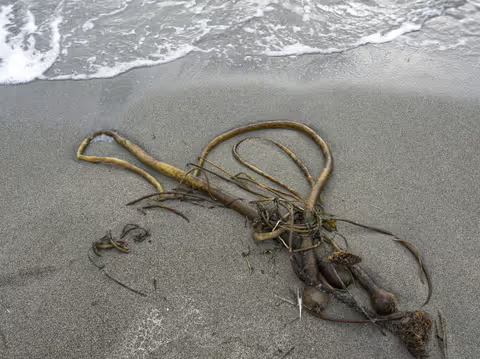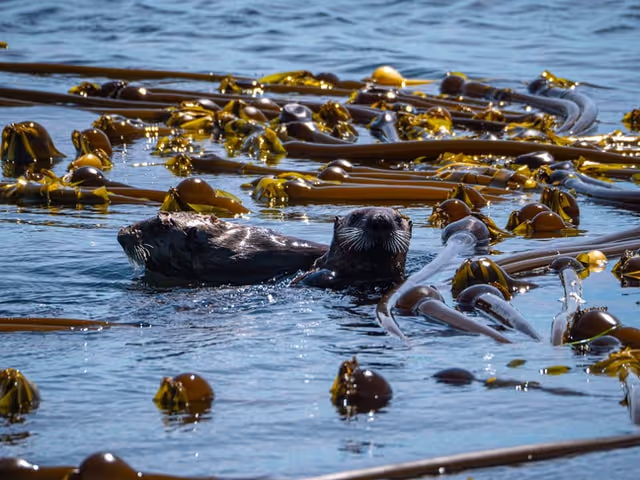Bull Kelp



Nereocystis lutkeana has many names. Its genus name Nereocystis is the Greek word for “mermaid’s bladder,” referring to the prominent bulb this algae features. It is more commonly known as bull kelp or bullwhip kelp, as the algae resembles a bullwhip in appearance. Other names include ribbon kelp, horsetail kelp, and sea otter’s cabbage.
Bull kelp is the largest species of brown kelp and one of the largest species of kelp in the Pacific Ocean. It prefers colder water, typically between 39° to 59°F (3.9°–15°C). They can be found in Puget Sound and the Pacific Ocean anywhere between San Luis Obispo County, California and the Aleutian Islands of Alaska. They are the most prolific kelp species within the Pacific Northwest. Despite being a species of brown kelp, bull kelp are greener in appearance and only turn brown when they are washed onto the beach and begin to dry out.
Bull kelp prefer growing on rocky surfaces in the subtidal region in areas that are at least 65-98 feet (20-30 meters) deep. A root-like structure called a holdfast or haptera keeps them in place. These structures can reach about 16 inches (40 centimeters) across. They are capable of growing up to 115 feet (35 meters) in length. The stalk (called a stripe) accounts for about 94.5 feet (30 meters) of this length. On top of this, bull kelp are capable of stretching up to a third of their length.
The bulb (called a pneumatocyst) is about 4 inches (10 centimeters) in diameter and filled with up to 10% carbon monoxide. This allows the kelp to remain upright in the water and receive adequate sunlight for photosynthesis. Growing from the bulb are two clusters of 30 to 64 leaf-like blades, each up to nearly ten feet (3 meters) in length.
Bull kelp is an annual species, meaning they grow from spore to full maturity within one year. During the summer and fall months, a sori containing spores is released. The sori is heavy enough to sink and thus offspring tend to remain close to the parent, ensuring they grow on adequate substrate. They grow throughout the spring and summer and are capable of growing very quickly, up to 10 inches (25 centimeters) a day. They can reach maturity in one season. During the winter, they begin to die off and winter storms often wash them onto the beach.

As bull kelp tend to grow close to one another, they can form dense kelp forests that serve as an important habitat for many creatures including young fish and invertebrates such as crabs and sea urchins. Sea otters will attach themselves to bull kelp so they don’t get swept away while they sleep. In addition, kelp forests help protect our shores from extreme wave action.
Washington State requires you to have a Shellfish/Seaweed license to harvest bull kelp. According to current regulations, “Bull kelp must be cut a minimum of 24 inches above the bulb and short stemmed kelps must be cut a minimum of 12 inches above the anchor point. The anchor point must be left in place at all times” (Washington Sport Fishing Rules). They are best harvested during the summer months.
The imagination’s the limit when it comes to uses for bull kelp. The bulb, stripe, and blades of the algae are edible and they are a good source of sodium, potassium, fiber, iodine, and magnesium. They can be canned, pickled, dried into chips, and used in sushi, stir-fries, salads, and soups. They are also used as a thickening agent in salad dressings, lotion, and paint. Indigenous peoples would use the stripes for fishing lines, ropes, and nets and the bulb to store oils and rendered fats.
References
Koukel, S., & Rodgers Dinstel, R. (2015). Bullwhip Kelp. Retrieved October 28, 2020, from http://cespubs.uaf.edu/index.php/download_file/1381/
Monterey Bay Aquarium. Bull Kelp. (n.d.). Retrieved October 28, 2020, from https://www.montereybayaquarium.org/animals/animals-a-to-z/bull-kelp
Sanctuary Integrated Monitoring Network. Bull Kelp. (n.d.). Retrieved October 28, 2020, from https://sanctuarysimon.org/dbtools/species-database/id/75/nereocystis/luetkeana/bull-kelp/
Turner, N. J. (1998). Plant Technology of First Peoples in British Columbia. Victoria, British Columbia: Royal British Columbia Museum.
Washington Sport Fishing Rules. (n.d.). Shellfish/Seaweed Species Rules. Retrieved October 28, 2020, from http://www.eregulations.com/washington/fishing/shellfishseaweed-species-rules/
© Laura Caldwell, November 2020
Touch whale bones, examine shipwreck artifacts and connect with the coast's living history.

Support our mission, get involved in educational programs, or contribute through donations and volunteering.